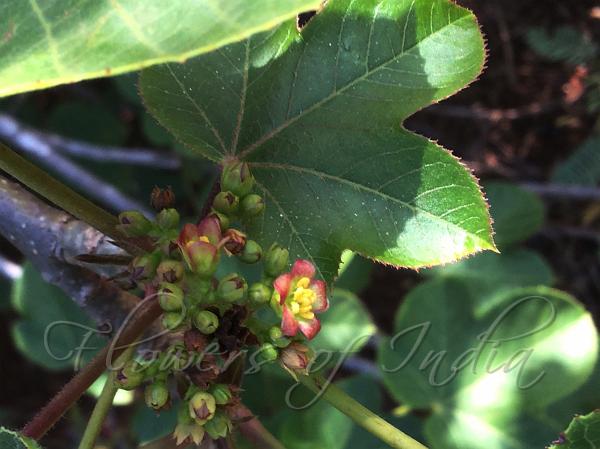|
| Tanjore Jatropha |
|

|

| File size | 556276 |
| Original date | 8/7/16 7:59 AM |
| Resolution | 2048 x 1536 |
| Flash | Flash did not fire |
| Focal length | 3.3mm |
| Exposure time | 1/100s |
| Aperture | 2.4 |
| Focus Distance | |
| Metering Mode | Multi-segment |
| Camera make | Apple |
| Camera model | iPad Air 2 |
| Sensor type | OneChipColorArea |
|
|
|
|
Photo: |
Botanical name: Jatropha tanjorensis Family: Euphorbiaceae (Castor family)
Tanjore Jatropha is a shrub up to 3 m tall with
leaves alternate, shortly 5-lobed, 7.5-11 x 6.5-10 cm, thinly
velvet-hairy along nerves. Leaf base is nearly heart-shaped, margin
sawtoothed, serratures gland-tipped, tip pointed; leaf-stalk 6-10 cm;
stipules fringed with hairs, glandular. Flowers are borne in cymes
about 9 cm wide; bracts lanceshaped, 1 x 0.3 cm, or smaller in
successive forkings; flower-stalk to 3 mm. Flowers are polygamous;
bisexual flowers 9 mm across; male ones smaller, generally opening
after bisexual flowers. Outer tepals pinkish-green, unequal,
lanceshaped, 5-7 mm, sawtoothed, glandular, hairy, tapering; inner ones
greenish yellow in bisexual flowers, pinkish in male, obovate, 5-7 mm,
hairy within at base, decurrent, blunt. Stamens 8, free; filaments 3
mm; anthers 1 mm, bearded. Ovary 2.5 x 2 mm; styles 2 mm long. Tanjore
Jatropha is found in Peninsular India and Africa. Flowering:
November-December.
Medicinal uses: IN Africa, Tanjore Jatropha is
commonly called “Hospital too far”, “Catholic vegetable”,
“Iyana-ipaja”, “Lapalapa”. Its primary use is for fencing while its
secondary uses are as a source of edible leafy vegetables and medicine.
It is
useful in herbal medicine, prepared locally in most parts of
Southern Nigeria by collecting the leaves and squeezing out the juice.
IN Africa, Tanjore Jatropha is
commonly called “Hospital too far”, “Catholic vegetable”,
“Iyana-ipaja”, “Lapalapa”. Its primary use is for fencing while its
secondary uses are as a source of edible leafy vegetables and medicine.
It is
useful in herbal medicine, prepared locally in most parts of
Southern Nigeria by collecting the leaves and squeezing out the juice.
Medicinal uses:
 IN Africa, Tanjore Jatropha is
commonly called “Hospital too far”, “Catholic vegetable”,
“Iyana-ipaja”, “Lapalapa”. Its primary use is for fencing while its
secondary uses are as a source of edible leafy vegetables and medicine.
It is
useful in herbal medicine, prepared locally in most parts of
Southern Nigeria by collecting the leaves and squeezing out the juice.
IN Africa, Tanjore Jatropha is
commonly called “Hospital too far”, “Catholic vegetable”,
“Iyana-ipaja”, “Lapalapa”. Its primary use is for fencing while its
secondary uses are as a source of edible leafy vegetables and medicine.
It is
useful in herbal medicine, prepared locally in most parts of
Southern Nigeria by collecting the leaves and squeezing out the juice.
| Identification credit: S. Kasim | Photographed at Karaikudi, Tamil Nadu. |
• Is this flower misidentified? If yes,